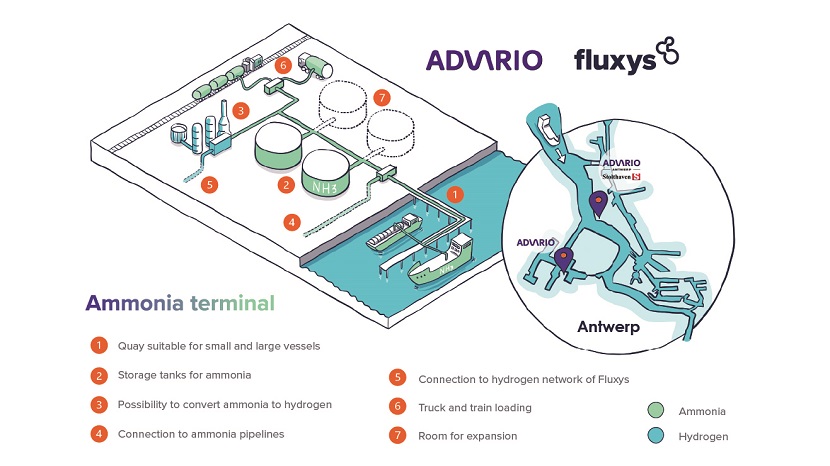Ammonia import terminal
Driving Europe's hydrogen strategy: Fluxys and Advario join forces to develop a green ammonia import terminal at the Port of Antwerp-Bruges
Fluxys, Advario Stolthaven Antwerp and Advario Gas Terminal have joined forces to study the feasibility of building an open-access green ammonia import terminal at the Port of Antwerp-Bruges. The plan is to offer the market a robust solution to its growing demands for importing and storing green energy and raw materials against a backdrop of ongoing decarbonisation.
Optimum ammonia terminalling infrastructure
By combining their strengths and expertise in logistics, terminalling and pipeline transmission, Fluxys, Advario Stolthaven Antwerp (a 50-50 joint venture with Stolthaven Terminals) and Advario Gas Terminal want to ascertain the optimum ammonia terminalling solution for northwest Europe. They aim to have the terminal operational in 2027/2028. Fluxys and the Advario terminals are now engaging with major industrial operators and energy suppliers to introduce their project.

Ideally located in the heart of Europe, at Belgium's Port of Antwerp-Bruges, the future terminal will deliver storage and multimodal sendout solutions for ammonia (train, truck, barge and possibly ammonia pipelines connected to local industrial sites), while optionally also providing facilities to convert ammonia back into hydrogen. The terminal will also connect to the Fluxys open-access hydrogen network to ensure supply throughout northwest Europe.
European hub
The ammonia import terminal dovetails seamlessly with the partners’ strategy for implementing Europe's hydrogen strategy and the REPowerEU plan by providing decarbonisation infrastructure and effectively making Belgium a European hub for the import and export of molecules essential to the carbon-neutral economy. REPowerEU has set a target of 20 million tonnes of green hydrogen consumption by 2030, one fifth of which should be covered by ammonia imports.
Pascal De Buck, CEO Fluxys: "We are delighted to launch this green ammonia import terminal project with our Advario partners. Combining and leveraging our terminalling and technology expertise will enable us to fast-track the development of key solutions for importing low-carbon energy and feedstock. Fluxys aims to be a decarbonisation driving force and this project is a landmark venture in helping build the infrastructure to carry the molecules needed for a carbon-neutral society."
Bas Verkooijen, CEO Advario: "Together with Stolthaven Terminals, our longstanding partner in Antwerp, we are very excited about this partnership with Fluxys. This new relationship is all about combining our strengths, know-how and experience to develop the logistics infrastructure required to accelerate the energy transition. As partners we are strongly united by our shared vision of playing a leading role in addressing climate change."
Jacques Vandermeiren, CEO Port of Antwerp-Bruges: "Port of Antwerp-Bruges is ready to receive sustainable molecules. As ammonia is one of the most efficient hydrogen carriers known, it will play a crucial role in the energy transition. The collaboration between Fluxys and Advario and the joint development of a green ammonia import terminal fully contributes to this goal. This is again an important step in the energy transition and in achieving a climate-neutral industry in our port."
Why import green ammonia?
Ammonia is a key factor in the decarbonisation of Europe and importing it is an efficient way of bringing in large quantities of green energy and raw materials from overseas, where the abundance of solar and wind energy can be used to make hydrogen (H2), which can then be combined with nitrogen (N2) from the air to produce ammonia.
- Ammonia is a carbon-free molecule that is much more efficient and cheaper than hydrogen to store and transport in large volumes due to its higher energy density.
- At the destination port, the ammonia can be used as a raw material in the production of, for example, fertiliser, thus contributing to the global food supply and playing a key role in our everyday lives.
- It can also be used directly as a sustainable fuel in the shipping industry. Moreover, it can be converted back into green hydrogen, which in turn can power turbines, fuel cells and engines – all without any direct CO2 emissions. In other words, ammonia will help to cost-effectively decarbonise industrial processes. As a sustainable energy source, it can help Europe diversify its energy supply and reduce its carbon emissions.